Dissertation on Anaemia Prevalence and Government Strategies in India
VerifiedAdded on 2022/12/27
|9
|2613
|1
Dissertation
AI Summary
This dissertation delves into the critical public health issue of anaemia among pregnant women in India. It begins with an introduction outlining the background, aims, objectives, research questions, rationale, scope, and limitations of the study. The literature review explores the causing factors of anaemia, primarily iron deficiency due to poor diet and lack of education, and examines government strategies for reducing its prevalence. The research investigates the prevalence rate of anaemia in India, particularly among women aged 20-30, identifying socio-demographic factors and other causes like poor diet, kitchen smoke, and irregular supplement intake. The study analyzes the government's actions to combat anaemia, aiming to identify effective strategies for prevention and reduction of mortality rates. The research methodology focuses on identifying factors associated with anaemia and strategies for reducing it, with the goal of informing public health interventions and improving maternal health outcomes. The study emphasizes the importance of healthy diets and other strategies to increase haemoglobin levels and reduce the prevalence of anaemia, with the ultimate goal of improving the health and well-being of pregnant women in India and reducing associated risks such as low birth weight, stillbirths, and maternal morbidity and mortality.
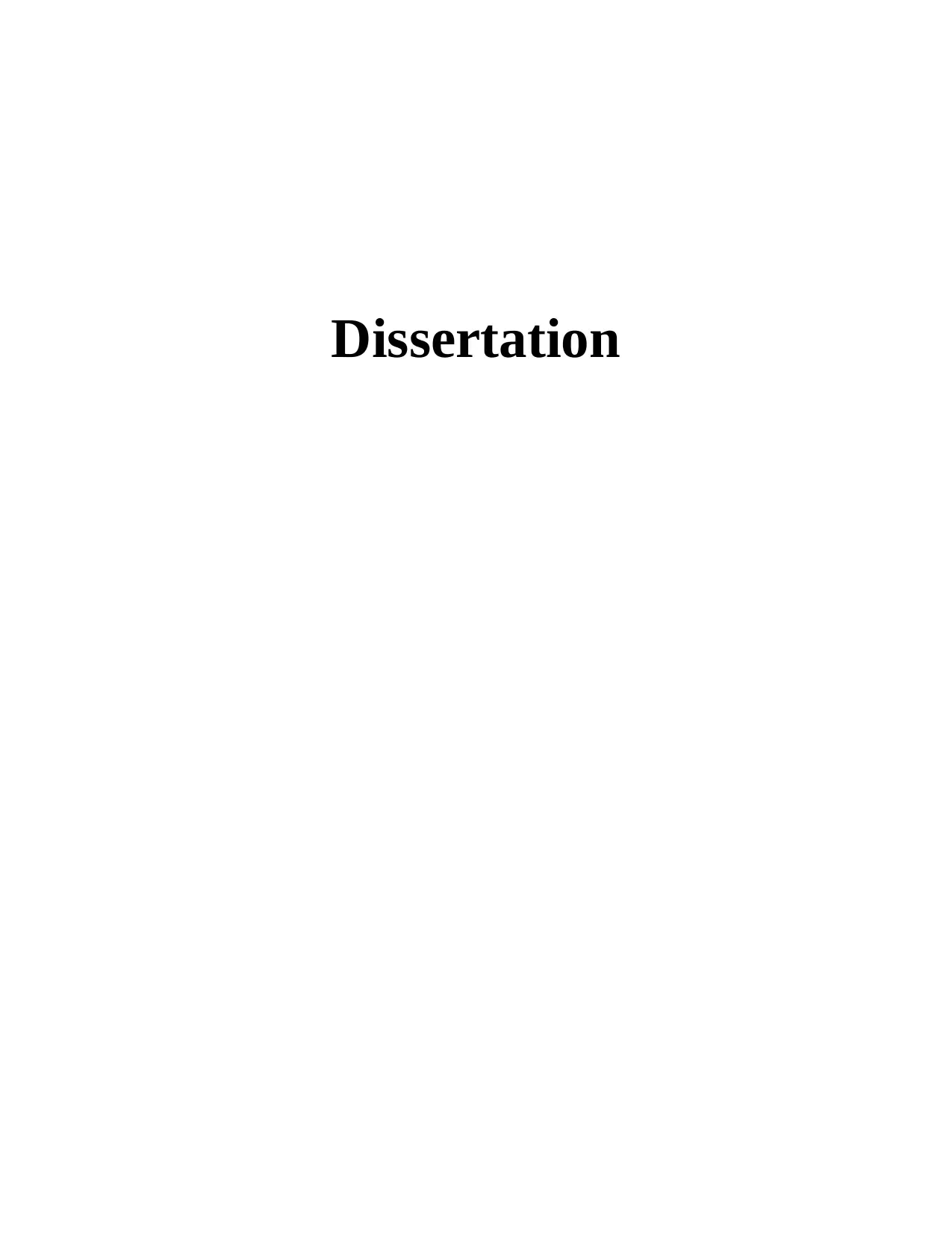
Dissertation
Paraphrase This Document
Need a fresh take? Get an instant paraphrase of this document with our AI Paraphraser
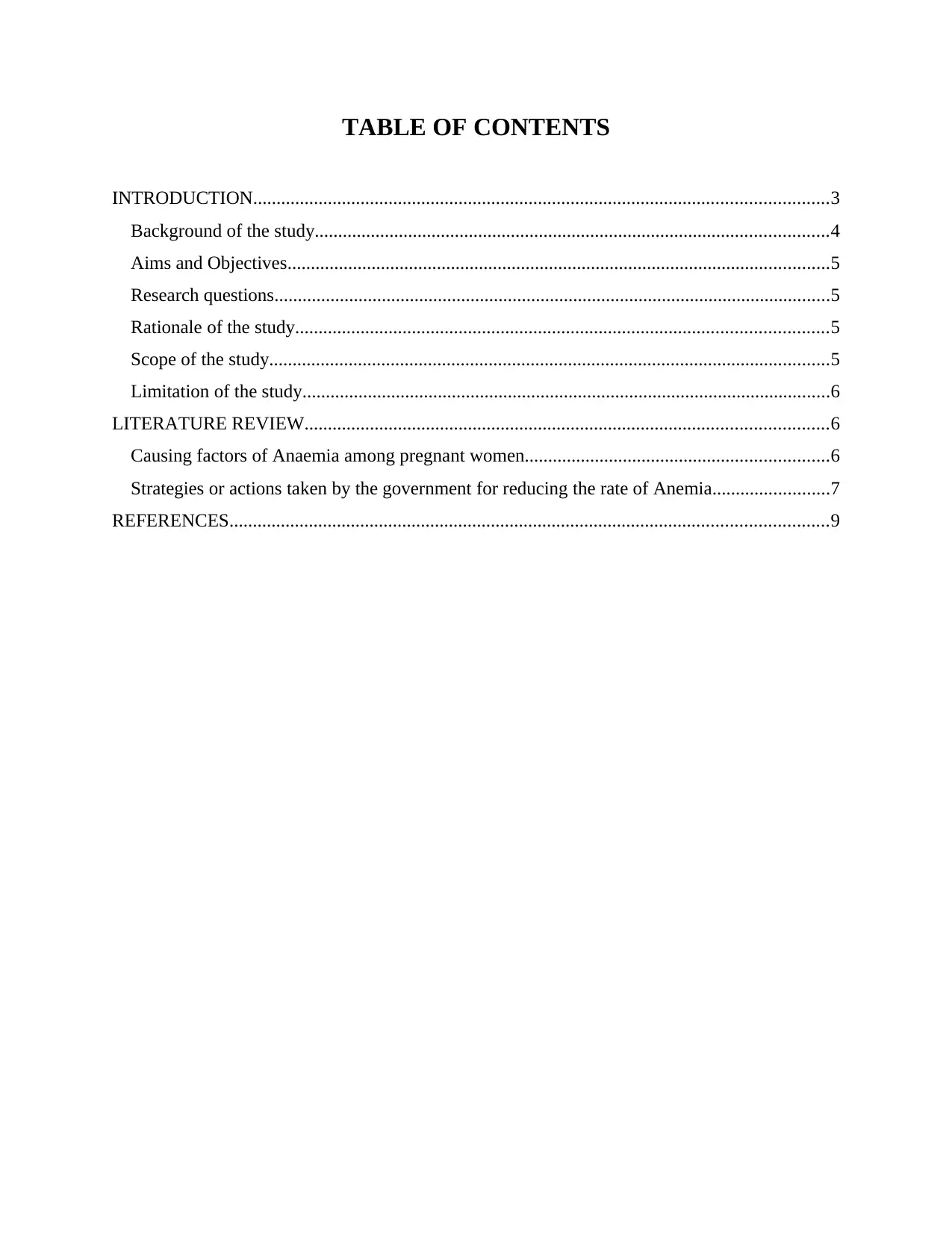
TABLE OF CONTENTS
INTRODUCTION...........................................................................................................................3
Background of the study..............................................................................................................4
Aims and Objectives....................................................................................................................5
Research questions.......................................................................................................................5
Rationale of the study..................................................................................................................5
Scope of the study........................................................................................................................5
Limitation of the study.................................................................................................................6
LITERATURE REVIEW................................................................................................................6
Causing factors of Anaemia among pregnant women.................................................................6
Strategies or actions taken by the government for reducing the rate of Anemia.........................7
REFERENCES................................................................................................................................9
INTRODUCTION...........................................................................................................................3
Background of the study..............................................................................................................4
Aims and Objectives....................................................................................................................5
Research questions.......................................................................................................................5
Rationale of the study..................................................................................................................5
Scope of the study........................................................................................................................5
Limitation of the study.................................................................................................................6
LITERATURE REVIEW................................................................................................................6
Causing factors of Anaemia among pregnant women.................................................................6
Strategies or actions taken by the government for reducing the rate of Anemia.........................7
REFERENCES................................................................................................................................9
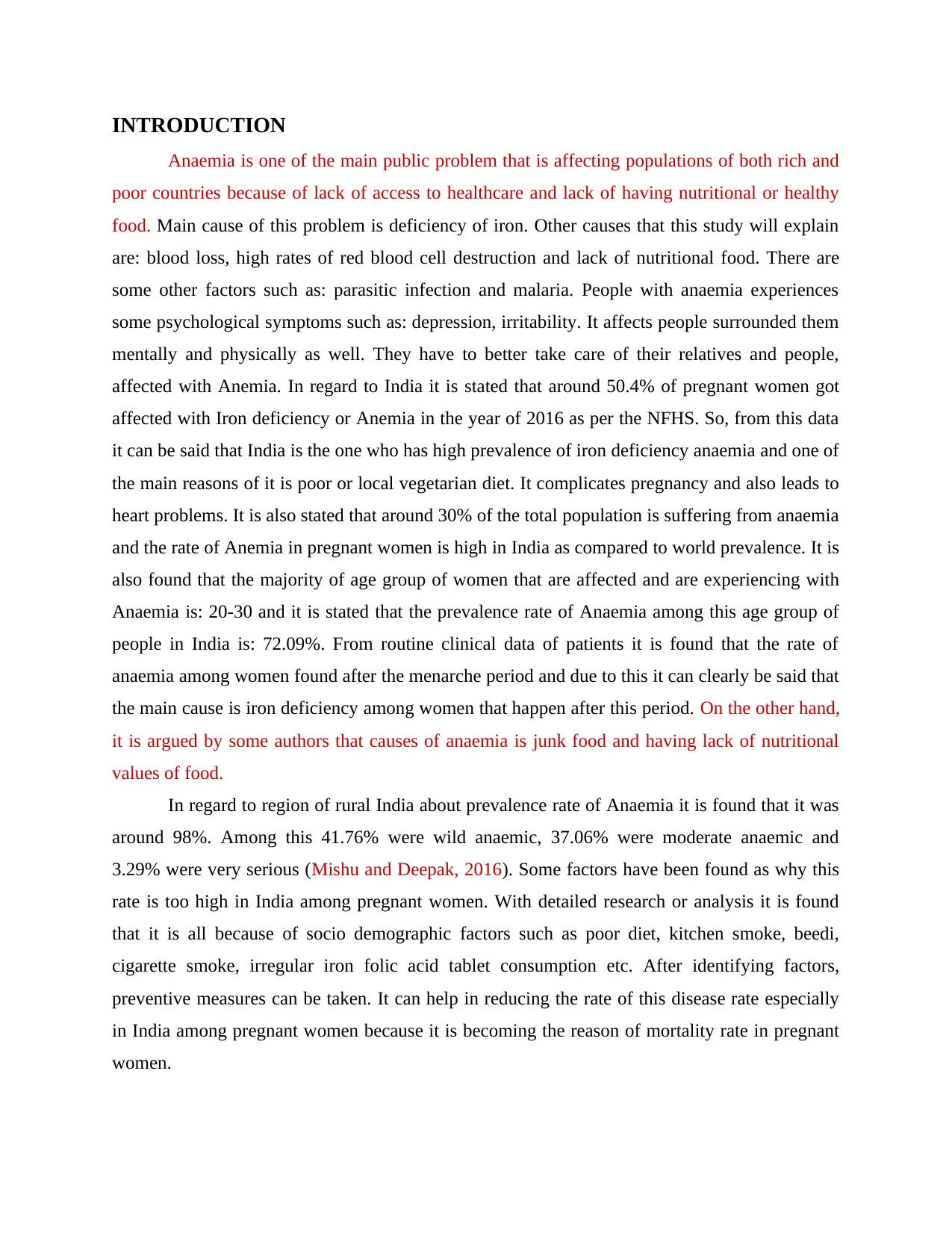
INTRODUCTION
Anaemia is one of the main public problem that is affecting populations of both rich and
poor countries because of lack of access to healthcare and lack of having nutritional or healthy
food. Main cause of this problem is deficiency of iron. Other causes that this study will explain
are: blood loss, high rates of red blood cell destruction and lack of nutritional food. There are
some other factors such as: parasitic infection and malaria. People with anaemia experiences
some psychological symptoms such as: depression, irritability. It affects people surrounded them
mentally and physically as well. They have to better take care of their relatives and people,
affected with Anemia. In regard to India it is stated that around 50.4% of pregnant women got
affected with Iron deficiency or Anemia in the year of 2016 as per the NFHS. So, from this data
it can be said that India is the one who has high prevalence of iron deficiency anaemia and one of
the main reasons of it is poor or local vegetarian diet. It complicates pregnancy and also leads to
heart problems. It is also stated that around 30% of the total population is suffering from anaemia
and the rate of Anemia in pregnant women is high in India as compared to world prevalence. It is
also found that the majority of age group of women that are affected and are experiencing with
Anaemia is: 20-30 and it is stated that the prevalence rate of Anaemia among this age group of
people in India is: 72.09%. From routine clinical data of patients it is found that the rate of
anaemia among women found after the menarche period and due to this it can clearly be said that
the main cause is iron deficiency among women that happen after this period. On the other hand,
it is argued by some authors that causes of anaemia is junk food and having lack of nutritional
values of food.
In regard to region of rural India about prevalence rate of Anaemia it is found that it was
around 98%. Among this 41.76% were wild anaemic, 37.06% were moderate anaemic and
3.29% were very serious (Mishu and Deepak, 2016). Some factors have been found as why this
rate is too high in India among pregnant women. With detailed research or analysis it is found
that it is all because of socio demographic factors such as poor diet, kitchen smoke, beedi,
cigarette smoke, irregular iron folic acid tablet consumption etc. After identifying factors,
preventive measures can be taken. It can help in reducing the rate of this disease rate especially
in India among pregnant women because it is becoming the reason of mortality rate in pregnant
women.
Anaemia is one of the main public problem that is affecting populations of both rich and
poor countries because of lack of access to healthcare and lack of having nutritional or healthy
food. Main cause of this problem is deficiency of iron. Other causes that this study will explain
are: blood loss, high rates of red blood cell destruction and lack of nutritional food. There are
some other factors such as: parasitic infection and malaria. People with anaemia experiences
some psychological symptoms such as: depression, irritability. It affects people surrounded them
mentally and physically as well. They have to better take care of their relatives and people,
affected with Anemia. In regard to India it is stated that around 50.4% of pregnant women got
affected with Iron deficiency or Anemia in the year of 2016 as per the NFHS. So, from this data
it can be said that India is the one who has high prevalence of iron deficiency anaemia and one of
the main reasons of it is poor or local vegetarian diet. It complicates pregnancy and also leads to
heart problems. It is also stated that around 30% of the total population is suffering from anaemia
and the rate of Anemia in pregnant women is high in India as compared to world prevalence. It is
also found that the majority of age group of women that are affected and are experiencing with
Anaemia is: 20-30 and it is stated that the prevalence rate of Anaemia among this age group of
people in India is: 72.09%. From routine clinical data of patients it is found that the rate of
anaemia among women found after the menarche period and due to this it can clearly be said that
the main cause is iron deficiency among women that happen after this period. On the other hand,
it is argued by some authors that causes of anaemia is junk food and having lack of nutritional
values of food.
In regard to region of rural India about prevalence rate of Anaemia it is found that it was
around 98%. Among this 41.76% were wild anaemic, 37.06% were moderate anaemic and
3.29% were very serious (Mishu and Deepak, 2016). Some factors have been found as why this
rate is too high in India among pregnant women. With detailed research or analysis it is found
that it is all because of socio demographic factors such as poor diet, kitchen smoke, beedi,
cigarette smoke, irregular iron folic acid tablet consumption etc. After identifying factors,
preventive measures can be taken. It can help in reducing the rate of this disease rate especially
in India among pregnant women because it is becoming the reason of mortality rate in pregnant
women.
⊘ This is a preview!⊘
Do you want full access?
Subscribe today to unlock all pages.

Trusted by 1+ million students worldwide
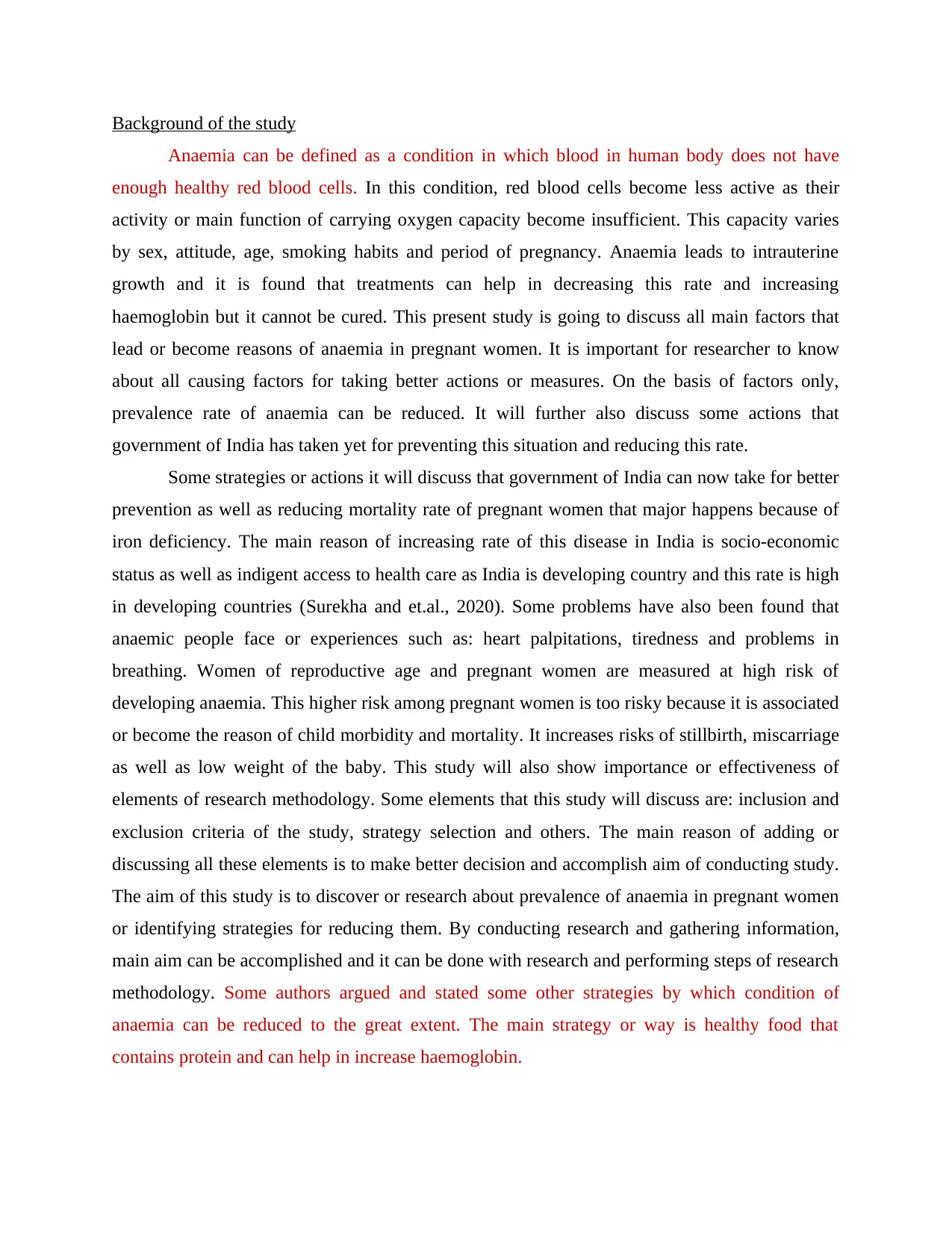
Background of the study
Anaemia can be defined as a condition in which blood in human body does not have
enough healthy red blood cells. In this condition, red blood cells become less active as their
activity or main function of carrying oxygen capacity become insufficient. This capacity varies
by sex, attitude, age, smoking habits and period of pregnancy. Anaemia leads to intrauterine
growth and it is found that treatments can help in decreasing this rate and increasing
haemoglobin but it cannot be cured. This present study is going to discuss all main factors that
lead or become reasons of anaemia in pregnant women. It is important for researcher to know
about all causing factors for taking better actions or measures. On the basis of factors only,
prevalence rate of anaemia can be reduced. It will further also discuss some actions that
government of India has taken yet for preventing this situation and reducing this rate.
Some strategies or actions it will discuss that government of India can now take for better
prevention as well as reducing mortality rate of pregnant women that major happens because of
iron deficiency. The main reason of increasing rate of this disease in India is socio-economic
status as well as indigent access to health care as India is developing country and this rate is high
in developing countries (Surekha and et.al., 2020). Some problems have also been found that
anaemic people face or experiences such as: heart palpitations, tiredness and problems in
breathing. Women of reproductive age and pregnant women are measured at high risk of
developing anaemia. This higher risk among pregnant women is too risky because it is associated
or become the reason of child morbidity and mortality. It increases risks of stillbirth, miscarriage
as well as low weight of the baby. This study will also show importance or effectiveness of
elements of research methodology. Some elements that this study will discuss are: inclusion and
exclusion criteria of the study, strategy selection and others. The main reason of adding or
discussing all these elements is to make better decision and accomplish aim of conducting study.
The aim of this study is to discover or research about prevalence of anaemia in pregnant women
or identifying strategies for reducing them. By conducting research and gathering information,
main aim can be accomplished and it can be done with research and performing steps of research
methodology. Some authors argued and stated some other strategies by which condition of
anaemia can be reduced to the great extent. The main strategy or way is healthy food that
contains protein and can help in increase haemoglobin.
Anaemia can be defined as a condition in which blood in human body does not have
enough healthy red blood cells. In this condition, red blood cells become less active as their
activity or main function of carrying oxygen capacity become insufficient. This capacity varies
by sex, attitude, age, smoking habits and period of pregnancy. Anaemia leads to intrauterine
growth and it is found that treatments can help in decreasing this rate and increasing
haemoglobin but it cannot be cured. This present study is going to discuss all main factors that
lead or become reasons of anaemia in pregnant women. It is important for researcher to know
about all causing factors for taking better actions or measures. On the basis of factors only,
prevalence rate of anaemia can be reduced. It will further also discuss some actions that
government of India has taken yet for preventing this situation and reducing this rate.
Some strategies or actions it will discuss that government of India can now take for better
prevention as well as reducing mortality rate of pregnant women that major happens because of
iron deficiency. The main reason of increasing rate of this disease in India is socio-economic
status as well as indigent access to health care as India is developing country and this rate is high
in developing countries (Surekha and et.al., 2020). Some problems have also been found that
anaemic people face or experiences such as: heart palpitations, tiredness and problems in
breathing. Women of reproductive age and pregnant women are measured at high risk of
developing anaemia. This higher risk among pregnant women is too risky because it is associated
or become the reason of child morbidity and mortality. It increases risks of stillbirth, miscarriage
as well as low weight of the baby. This study will also show importance or effectiveness of
elements of research methodology. Some elements that this study will discuss are: inclusion and
exclusion criteria of the study, strategy selection and others. The main reason of adding or
discussing all these elements is to make better decision and accomplish aim of conducting study.
The aim of this study is to discover or research about prevalence of anaemia in pregnant women
or identifying strategies for reducing them. By conducting research and gathering information,
main aim can be accomplished and it can be done with research and performing steps of research
methodology. Some authors argued and stated some other strategies by which condition of
anaemia can be reduced to the great extent. The main strategy or way is healthy food that
contains protein and can help in increase haemoglobin.
Paraphrase This Document
Need a fresh take? Get an instant paraphrase of this document with our AI Paraphraser
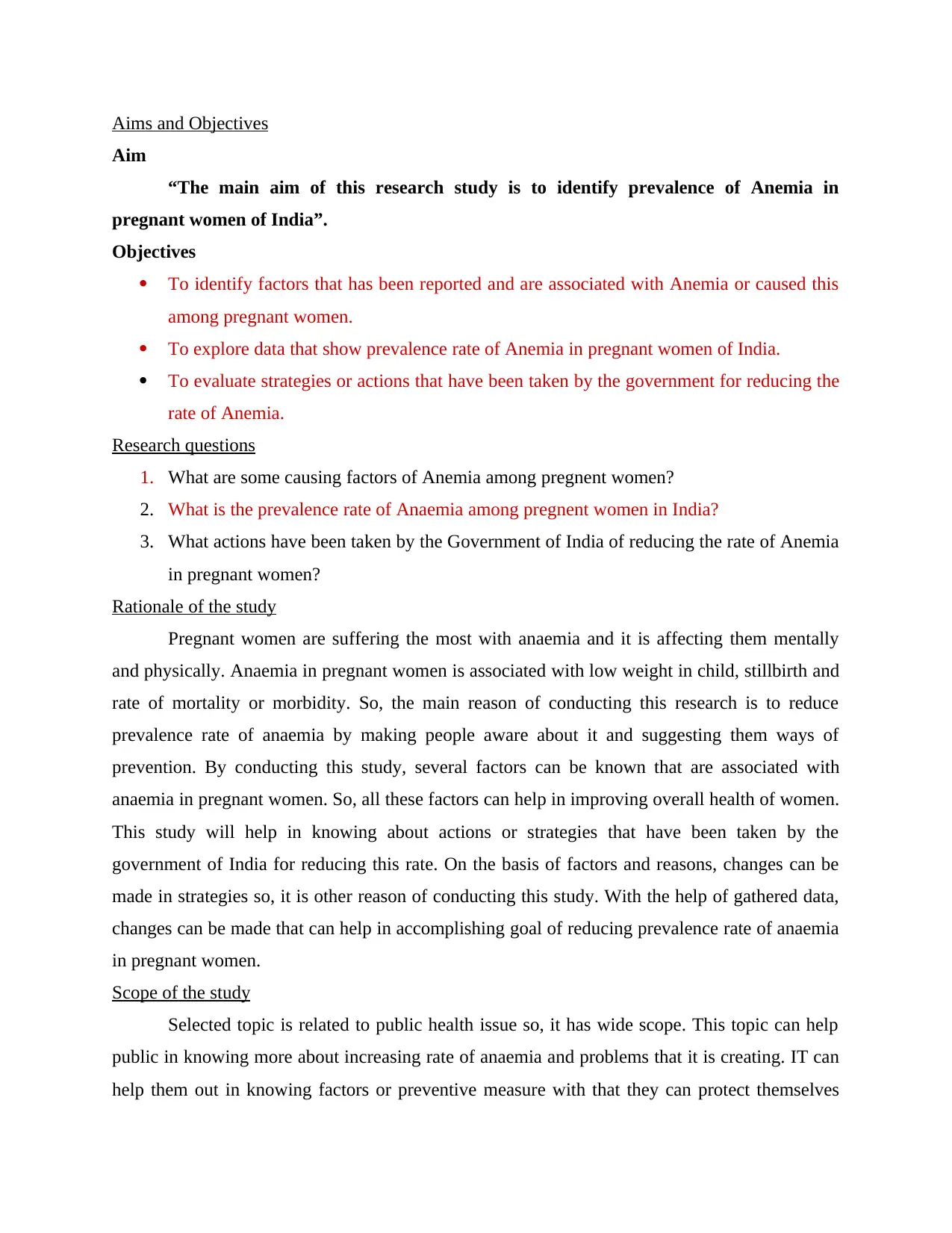
Aims and Objectives
Aim
“The main aim of this research study is to identify prevalence of Anemia in
pregnant women of India”.
Objectives
To identify factors that has been reported and are associated with Anemia or caused this
among pregnant women.
To explore data that show prevalence rate of Anemia in pregnant women of India.
To evaluate strategies or actions that have been taken by the government for reducing the
rate of Anemia.
Research questions
1. What are some causing factors of Anemia among pregnent women?
2. What is the prevalence rate of Anaemia among pregnent women in India?
3. What actions have been taken by the Government of India of reducing the rate of Anemia
in pregnant women?
Rationale of the study
Pregnant women are suffering the most with anaemia and it is affecting them mentally
and physically. Anaemia in pregnant women is associated with low weight in child, stillbirth and
rate of mortality or morbidity. So, the main reason of conducting this research is to reduce
prevalence rate of anaemia by making people aware about it and suggesting them ways of
prevention. By conducting this study, several factors can be known that are associated with
anaemia in pregnant women. So, all these factors can help in improving overall health of women.
This study will help in knowing about actions or strategies that have been taken by the
government of India for reducing this rate. On the basis of factors and reasons, changes can be
made in strategies so, it is other reason of conducting this study. With the help of gathered data,
changes can be made that can help in accomplishing goal of reducing prevalence rate of anaemia
in pregnant women.
Scope of the study
Selected topic is related to public health issue so, it has wide scope. This topic can help
public in knowing more about increasing rate of anaemia and problems that it is creating. IT can
help them out in knowing factors or preventive measure with that they can protect themselves
Aim
“The main aim of this research study is to identify prevalence of Anemia in
pregnant women of India”.
Objectives
To identify factors that has been reported and are associated with Anemia or caused this
among pregnant women.
To explore data that show prevalence rate of Anemia in pregnant women of India.
To evaluate strategies or actions that have been taken by the government for reducing the
rate of Anemia.
Research questions
1. What are some causing factors of Anemia among pregnent women?
2. What is the prevalence rate of Anaemia among pregnent women in India?
3. What actions have been taken by the Government of India of reducing the rate of Anemia
in pregnant women?
Rationale of the study
Pregnant women are suffering the most with anaemia and it is affecting them mentally
and physically. Anaemia in pregnant women is associated with low weight in child, stillbirth and
rate of mortality or morbidity. So, the main reason of conducting this research is to reduce
prevalence rate of anaemia by making people aware about it and suggesting them ways of
prevention. By conducting this study, several factors can be known that are associated with
anaemia in pregnant women. So, all these factors can help in improving overall health of women.
This study will help in knowing about actions or strategies that have been taken by the
government of India for reducing this rate. On the basis of factors and reasons, changes can be
made in strategies so, it is other reason of conducting this study. With the help of gathered data,
changes can be made that can help in accomplishing goal of reducing prevalence rate of anaemia
in pregnant women.
Scope of the study
Selected topic is related to public health issue so, it has wide scope. This topic can help
public in knowing more about increasing rate of anaemia and problems that it is creating. IT can
help them out in knowing factors or preventive measure with that they can protect themselves
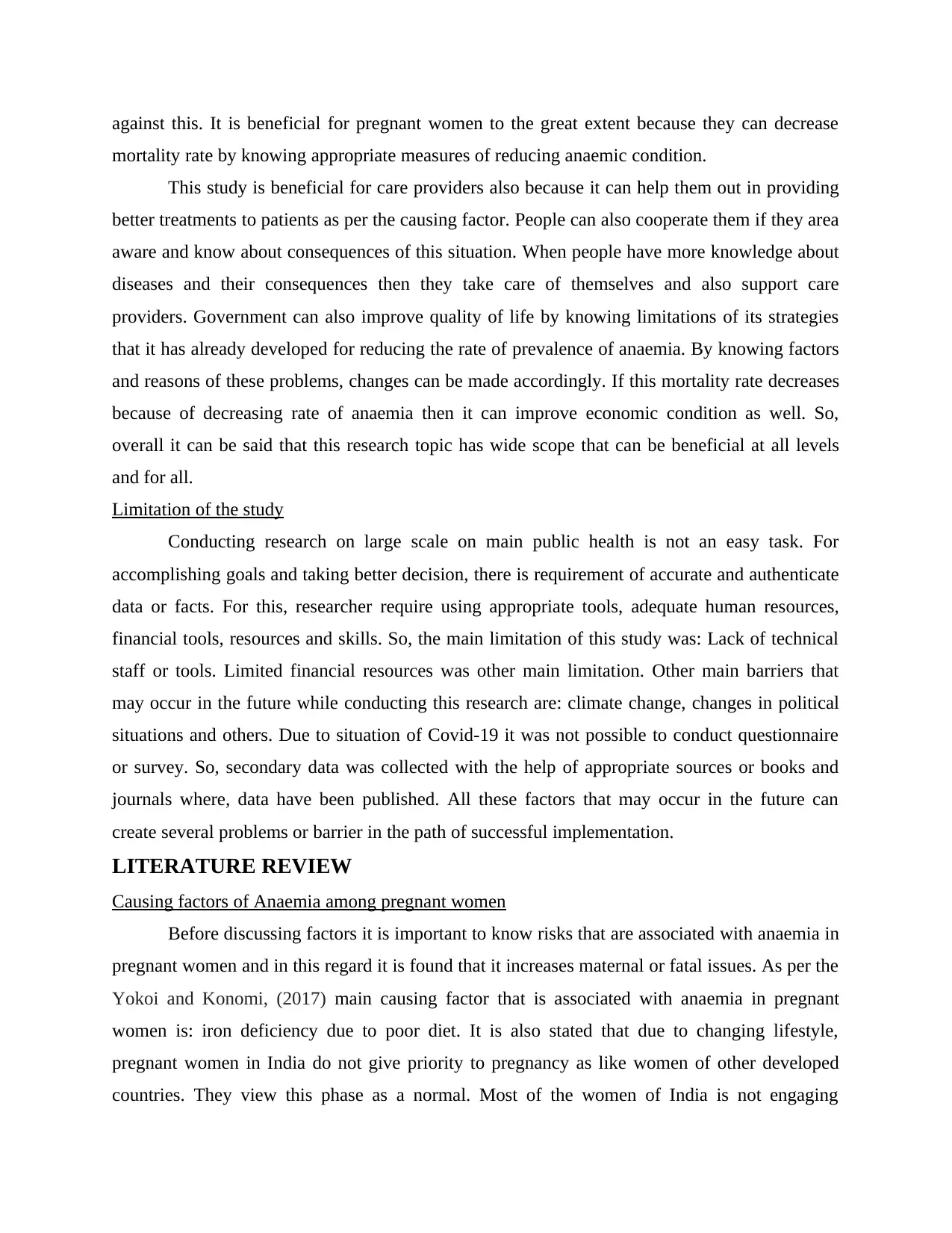
against this. It is beneficial for pregnant women to the great extent because they can decrease
mortality rate by knowing appropriate measures of reducing anaemic condition.
This study is beneficial for care providers also because it can help them out in providing
better treatments to patients as per the causing factor. People can also cooperate them if they area
aware and know about consequences of this situation. When people have more knowledge about
diseases and their consequences then they take care of themselves and also support care
providers. Government can also improve quality of life by knowing limitations of its strategies
that it has already developed for reducing the rate of prevalence of anaemia. By knowing factors
and reasons of these problems, changes can be made accordingly. If this mortality rate decreases
because of decreasing rate of anaemia then it can improve economic condition as well. So,
overall it can be said that this research topic has wide scope that can be beneficial at all levels
and for all.
Limitation of the study
Conducting research on large scale on main public health is not an easy task. For
accomplishing goals and taking better decision, there is requirement of accurate and authenticate
data or facts. For this, researcher require using appropriate tools, adequate human resources,
financial tools, resources and skills. So, the main limitation of this study was: Lack of technical
staff or tools. Limited financial resources was other main limitation. Other main barriers that
may occur in the future while conducting this research are: climate change, changes in political
situations and others. Due to situation of Covid-19 it was not possible to conduct questionnaire
or survey. So, secondary data was collected with the help of appropriate sources or books and
journals where, data have been published. All these factors that may occur in the future can
create several problems or barrier in the path of successful implementation.
LITERATURE REVIEW
Causing factors of Anaemia among pregnant women
Before discussing factors it is important to know risks that are associated with anaemia in
pregnant women and in this regard it is found that it increases maternal or fatal issues. As per the
Yokoi and Konomi, (2017) main causing factor that is associated with anaemia in pregnant
women is: iron deficiency due to poor diet. It is also stated that due to changing lifestyle,
pregnant women in India do not give priority to pregnancy as like women of other developed
countries. They view this phase as a normal. Most of the women of India is not engaging
mortality rate by knowing appropriate measures of reducing anaemic condition.
This study is beneficial for care providers also because it can help them out in providing
better treatments to patients as per the causing factor. People can also cooperate them if they area
aware and know about consequences of this situation. When people have more knowledge about
diseases and their consequences then they take care of themselves and also support care
providers. Government can also improve quality of life by knowing limitations of its strategies
that it has already developed for reducing the rate of prevalence of anaemia. By knowing factors
and reasons of these problems, changes can be made accordingly. If this mortality rate decreases
because of decreasing rate of anaemia then it can improve economic condition as well. So,
overall it can be said that this research topic has wide scope that can be beneficial at all levels
and for all.
Limitation of the study
Conducting research on large scale on main public health is not an easy task. For
accomplishing goals and taking better decision, there is requirement of accurate and authenticate
data or facts. For this, researcher require using appropriate tools, adequate human resources,
financial tools, resources and skills. So, the main limitation of this study was: Lack of technical
staff or tools. Limited financial resources was other main limitation. Other main barriers that
may occur in the future while conducting this research are: climate change, changes in political
situations and others. Due to situation of Covid-19 it was not possible to conduct questionnaire
or survey. So, secondary data was collected with the help of appropriate sources or books and
journals where, data have been published. All these factors that may occur in the future can
create several problems or barrier in the path of successful implementation.
LITERATURE REVIEW
Causing factors of Anaemia among pregnant women
Before discussing factors it is important to know risks that are associated with anaemia in
pregnant women and in this regard it is found that it increases maternal or fatal issues. As per the
Yokoi and Konomi, (2017) main causing factor that is associated with anaemia in pregnant
women is: iron deficiency due to poor diet. It is also stated that due to changing lifestyle,
pregnant women in India do not give priority to pregnancy as like women of other developed
countries. They view this phase as a normal. Most of the women of India is not engaging
⊘ This is a preview!⊘
Do you want full access?
Subscribe today to unlock all pages.

Trusted by 1+ million students worldwide
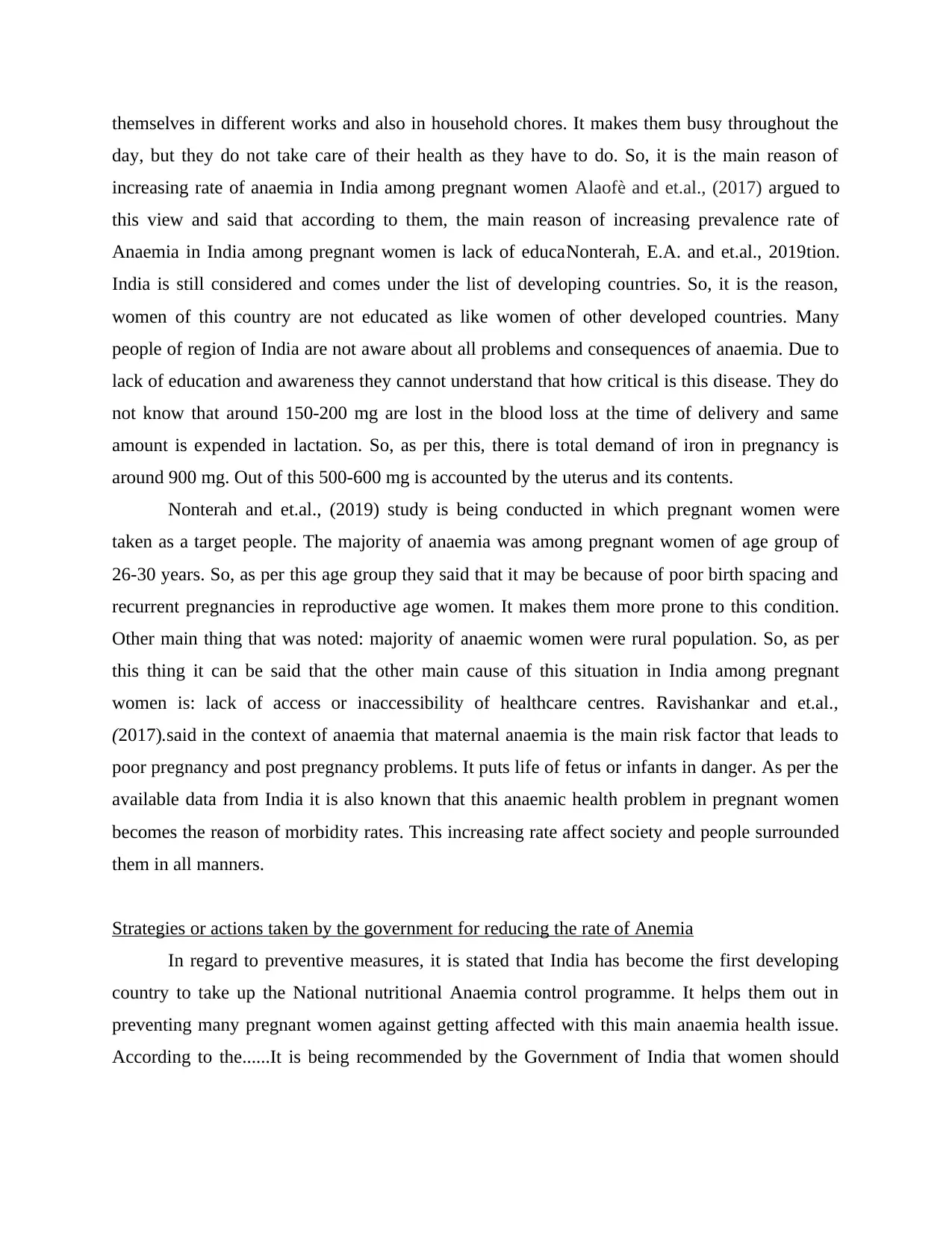
themselves in different works and also in household chores. It makes them busy throughout the
day, but they do not take care of their health as they have to do. So, it is the main reason of
increasing rate of anaemia in India among pregnant women Alaofè and et.al., (2017) argued to
this view and said that according to them, the main reason of increasing prevalence rate of
Anaemia in India among pregnant women is lack of educaNonterah, E.A. and et.al., 2019tion.
India is still considered and comes under the list of developing countries. So, it is the reason,
women of this country are not educated as like women of other developed countries. Many
people of region of India are not aware about all problems and consequences of anaemia. Due to
lack of education and awareness they cannot understand that how critical is this disease. They do
not know that around 150-200 mg are lost in the blood loss at the time of delivery and same
amount is expended in lactation. So, as per this, there is total demand of iron in pregnancy is
around 900 mg. Out of this 500-600 mg is accounted by the uterus and its contents.
Nonterah and et.al., (2019) study is being conducted in which pregnant women were
taken as a target people. The majority of anaemia was among pregnant women of age group of
26-30 years. So, as per this age group they said that it may be because of poor birth spacing and
recurrent pregnancies in reproductive age women. It makes them more prone to this condition.
Other main thing that was noted: majority of anaemic women were rural population. So, as per
this thing it can be said that the other main cause of this situation in India among pregnant
women is: lack of access or inaccessibility of healthcare centres. Ravishankar and et.al.,
(2017).said in the context of anaemia that maternal anaemia is the main risk factor that leads to
poor pregnancy and post pregnancy problems. It puts life of fetus or infants in danger. As per the
available data from India it is also known that this anaemic health problem in pregnant women
becomes the reason of morbidity rates. This increasing rate affect society and people surrounded
them in all manners.
Strategies or actions taken by the government for reducing the rate of Anemia
In regard to preventive measures, it is stated that India has become the first developing
country to take up the National nutritional Anaemia control programme. It helps them out in
preventing many pregnant women against getting affected with this main anaemia health issue.
According to the......It is being recommended by the Government of India that women should
day, but they do not take care of their health as they have to do. So, it is the main reason of
increasing rate of anaemia in India among pregnant women Alaofè and et.al., (2017) argued to
this view and said that according to them, the main reason of increasing prevalence rate of
Anaemia in India among pregnant women is lack of educaNonterah, E.A. and et.al., 2019tion.
India is still considered and comes under the list of developing countries. So, it is the reason,
women of this country are not educated as like women of other developed countries. Many
people of region of India are not aware about all problems and consequences of anaemia. Due to
lack of education and awareness they cannot understand that how critical is this disease. They do
not know that around 150-200 mg are lost in the blood loss at the time of delivery and same
amount is expended in lactation. So, as per this, there is total demand of iron in pregnancy is
around 900 mg. Out of this 500-600 mg is accounted by the uterus and its contents.
Nonterah and et.al., (2019) study is being conducted in which pregnant women were
taken as a target people. The majority of anaemia was among pregnant women of age group of
26-30 years. So, as per this age group they said that it may be because of poor birth spacing and
recurrent pregnancies in reproductive age women. It makes them more prone to this condition.
Other main thing that was noted: majority of anaemic women were rural population. So, as per
this thing it can be said that the other main cause of this situation in India among pregnant
women is: lack of access or inaccessibility of healthcare centres. Ravishankar and et.al.,
(2017).said in the context of anaemia that maternal anaemia is the main risk factor that leads to
poor pregnancy and post pregnancy problems. It puts life of fetus or infants in danger. As per the
available data from India it is also known that this anaemic health problem in pregnant women
becomes the reason of morbidity rates. This increasing rate affect society and people surrounded
them in all manners.
Strategies or actions taken by the government for reducing the rate of Anemia
In regard to preventive measures, it is stated that India has become the first developing
country to take up the National nutritional Anaemia control programme. It helps them out in
preventing many pregnant women against getting affected with this main anaemia health issue.
According to the......It is being recommended by the Government of India that women should
Paraphrase This Document
Need a fresh take? Get an instant paraphrase of this document with our AI Paraphraser

consume 100mg+500 ug of folic acid for prophylactic supplementation for minimum of 100
days.
days.
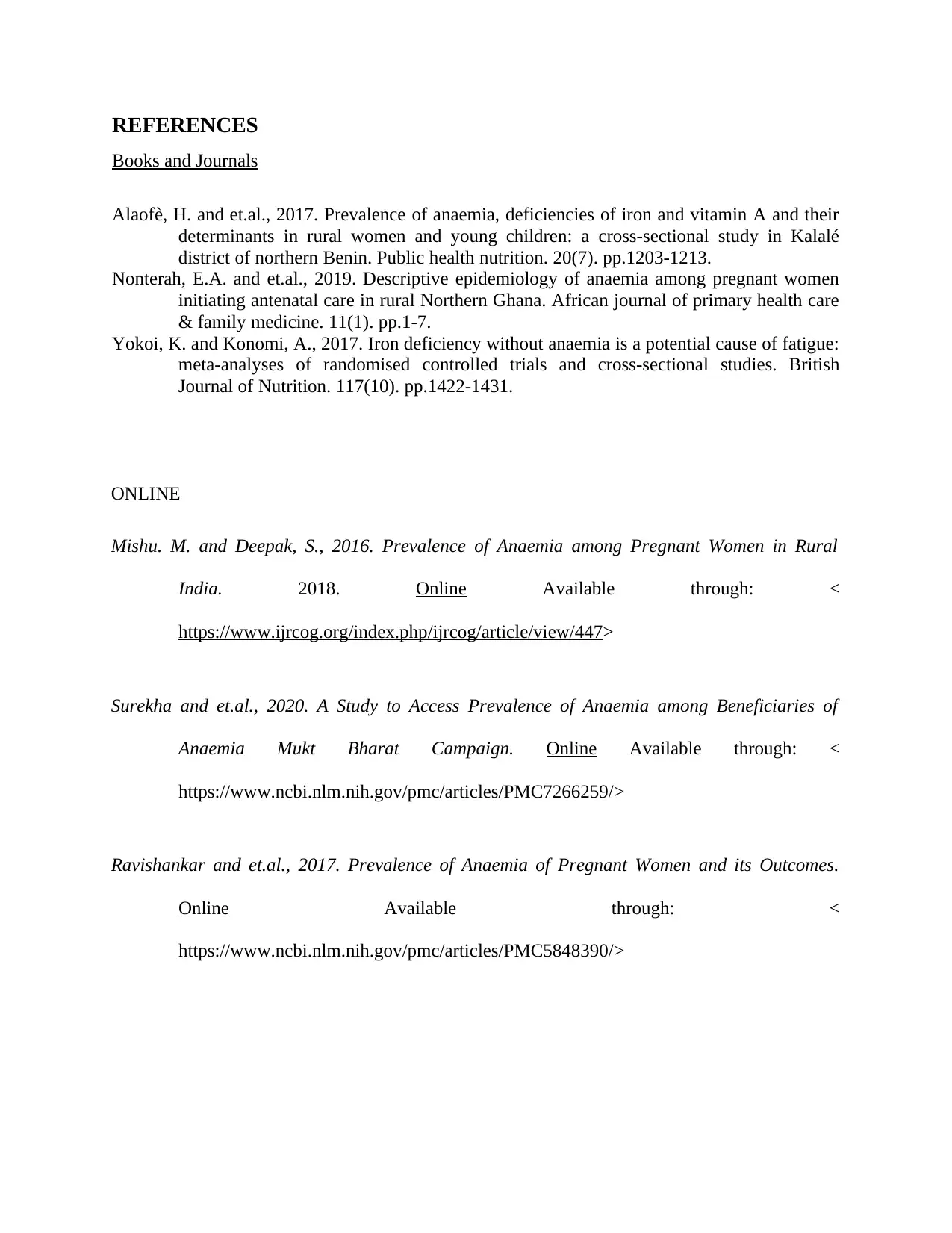
REFERENCES
Books and Journals
Alaofè, H. and et.al., 2017. Prevalence of anaemia, deficiencies of iron and vitamin A and their
determinants in rural women and young children: a cross-sectional study in Kalalé
district of northern Benin. Public health nutrition. 20(7). pp.1203-1213.
Nonterah, E.A. and et.al., 2019. Descriptive epidemiology of anaemia among pregnant women
initiating antenatal care in rural Northern Ghana. African journal of primary health care
& family medicine. 11(1). pp.1-7.
Yokoi, K. and Konomi, A., 2017. Iron deficiency without anaemia is a potential cause of fatigue:
meta-analyses of randomised controlled trials and cross-sectional studies. British
Journal of Nutrition. 117(10). pp.1422-1431.
ONLINE
Mishu. M. and Deepak, S., 2016. Prevalence of Anaemia among Pregnant Women in Rural
India. 2018. Online Available through: <
https://www.ijrcog.org/index.php/ijrcog/article/view/447>
Surekha and et.al., 2020. A Study to Access Prevalence of Anaemia among Beneficiaries of
Anaemia Mukt Bharat Campaign. Online Available through: <
https://www.ncbi.nlm.nih.gov/pmc/articles/PMC7266259/>
Ravishankar and et.al., 2017. Prevalence of Anaemia of Pregnant Women and its Outcomes.
Online Available through: <
https://www.ncbi.nlm.nih.gov/pmc/articles/PMC5848390/>
Books and Journals
Alaofè, H. and et.al., 2017. Prevalence of anaemia, deficiencies of iron and vitamin A and their
determinants in rural women and young children: a cross-sectional study in Kalalé
district of northern Benin. Public health nutrition. 20(7). pp.1203-1213.
Nonterah, E.A. and et.al., 2019. Descriptive epidemiology of anaemia among pregnant women
initiating antenatal care in rural Northern Ghana. African journal of primary health care
& family medicine. 11(1). pp.1-7.
Yokoi, K. and Konomi, A., 2017. Iron deficiency without anaemia is a potential cause of fatigue:
meta-analyses of randomised controlled trials and cross-sectional studies. British
Journal of Nutrition. 117(10). pp.1422-1431.
ONLINE
Mishu. M. and Deepak, S., 2016. Prevalence of Anaemia among Pregnant Women in Rural
India. 2018. Online Available through: <
https://www.ijrcog.org/index.php/ijrcog/article/view/447>
Surekha and et.al., 2020. A Study to Access Prevalence of Anaemia among Beneficiaries of
Anaemia Mukt Bharat Campaign. Online Available through: <
https://www.ncbi.nlm.nih.gov/pmc/articles/PMC7266259/>
Ravishankar and et.al., 2017. Prevalence of Anaemia of Pregnant Women and its Outcomes.
Online Available through: <
https://www.ncbi.nlm.nih.gov/pmc/articles/PMC5848390/>
⊘ This is a preview!⊘
Do you want full access?
Subscribe today to unlock all pages.

Trusted by 1+ million students worldwide
1 out of 9
Related Documents
Your All-in-One AI-Powered Toolkit for Academic Success.
+13062052269
info@desklib.com
Available 24*7 on WhatsApp / Email
![[object Object]](/_next/static/media/star-bottom.7253800d.svg)
Unlock your academic potential
Copyright © 2020–2025 A2Z Services. All Rights Reserved. Developed and managed by ZUCOL.





